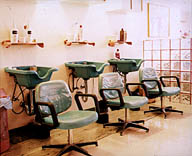The characteristics of a good shampoo are fairly obvious. A shampoo should clean away the oil and dirt, rinse out easily, and leave your hair shiny, manageable, and flexible. If you believe shampoo commercials, the right shampoo will also have good-looking strangers taking notice of your fabulous hair—but let's not get carried away. Let's try for a goal that's more achievable —clean, manageable hair.
 First,
the basics. To get oil out of your hair, you need to use soap or detergent.
You know the old saying "oil and water don't mix." Oil and grease
don't stick to water, which is why oil floats on water rather than mixing
in. So washing your hair with water alone doesn't get out the oil and
grease. Detergent and soap molecules have a dual nature: one end sticks
to grease; the other end sticks to water. When you wash your hair with
detergent or soap, the grease sticks to the detergent or soap and washes
away with the water.
First,
the basics. To get oil out of your hair, you need to use soap or detergent.
You know the old saying "oil and water don't mix." Oil and grease
don't stick to water, which is why oil floats on water rather than mixing
in. So washing your hair with water alone doesn't get out the oil and
grease. Detergent and soap molecules have a dual nature: one end sticks
to grease; the other end sticks to water. When you wash your hair with
detergent or soap, the grease sticks to the detergent or soap and washes
away with the water.
I took an informal survey of shampoo ingredients by looking at the labels of a couple of dozen shampoos in my local drugstore. In all of the ones I checked, the first ingredient listed after water was some kind of detergent. Since ingredients are listed in order of concentration, that means there is more detergent in shampoo than anything else except water.
Using detergent on your hair may sound a little harsh, but I can tell you that it's a good idea. I remember back in my hippy youth, when the cool folks were using Dr. Bronner's Peppermint Pure Castile Soap for shampoo. They figured it had to be better for your hair.

|
|
Wrong. According to the cosmetic chemists, detergent is actually better for your hair than soap. Soap solutions are alkaline, which makes the cuticle cells swell up and get rougher. That leaves h air dull looking. In addition, soap may leave behind deposits of calcium and magnesium (known as soap scum), which will also make the hair dull. Old-fashioned beauty books suggested completing your shampoo with a lemon juice or vinegar rinse. Acid helps dissolve soap scum and makes the cuticle scales lie flat, protecting the cortex and making your hair shiny and smooth. Most shampoos and conditioners are slightly acidic, for the same reason.
Take a look (left) at the ingredients
listed on a bottle of shampoo. Some of those ingredients are coloring,
fragrance, thickeners, glycol distearate (which gives shampoo an opalescent
look), and lather enhancers (which help it foam). More lather doesn't
necessarily mean that a shampoo is cleaning your hair any better, but
most Americans equate foam with cleaning power—so shampoo makers
add lather builders to make shampoos that lather really well. And some
of those ingredients condition your hair to make it more manageable.
![]()
You know the rest: I can't do a thing with it—the lament of someone
suffering from a Bad Hair Day.
How does conditioner—whether it's in your shampoo or in a different bottle—help you out? A conditioner leaves a smooth, waxy coating on the hair, strengthening the cuticle or forming a protective layer over the cortex where cuticule cells have broken away. Hair can tangle when the lifted edges of the cuticle layer on one hair get caught on the cuticle layer on another hair. By adding a coating that smooths out these rough edges, conditioner helps keep your hair from tangling. This coating also helps reduce static electricity and seals moisture into your hair, keeping it from getting dry and brittle.
I used to figure I should use more conditioner during times of Bad Hair, assuming that it could only help. Not true. I've learned that it's possible to overdo a good thing. Hairdressers talk about "over-conditioning" your hair. That means you've used so much conditioner that the waxy layers are weighing your hair down, making it limp and unmanageable.
My hair, which is short and perky when it's the right length and in the right mood, lies down limply when it's too long. At that point, more conditioner only makes it heavier and limper. So last night, just before I sat down to work on this article, I did a little experiment. While I was in the shower, I washed my hair with a clarifying shampoo (also known as an antiresidue shampoo) that has no conditioners at all. Such a shampoo cleans the hair and leaves nothing behind, stripping away any conditioners that may have built up. This morning, my hair is perkier than it's been for weeks. (Three cheers for science!)

